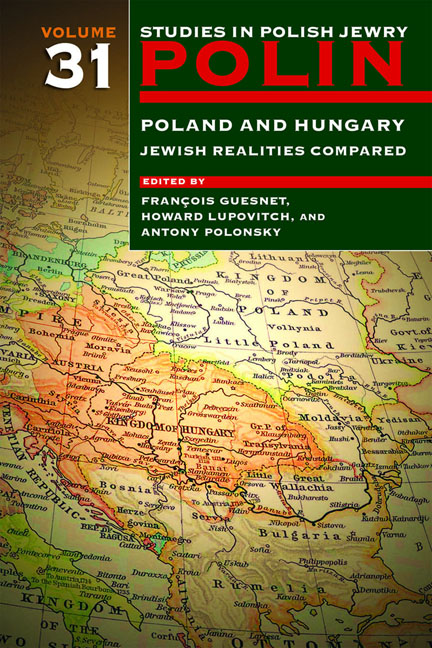Book contents
- Frontmatter
- Dedication
- Editors and Advisers
- Preface
- Polin
- Polin: Studies in Polish Jewry
- Contents
- Note on Place Names
- Note on Transliteration
- Part I POLAND AND HUNGARY: JEWISH REALITIES COMPARED
- JEWISH ACCULTURATION AND INTEGRATION
- JEWISH RELIGIOUS LIFE
- JEWS IN POPULAR CULTURE
- THE INTERWAR YEARS
- THE HOLOCAUST AND ITS AFTERMATH
- PERSONAL REFLECTIONS
- Part II NEW VIEWS
- Part III OBITUARIES
- Notes on the Contributors
- Index
Integration and Its Discontents: Humorous Magazines and Music Halls As Reflections of the Ambiguous Transformation of Budapest Jews Into Magyars of the Jewish Faith
- Frontmatter
- Dedication
- Editors and Advisers
- Preface
- Polin
- Polin: Studies in Polish Jewry
- Contents
- Note on Place Names
- Note on Transliteration
- Part I POLAND AND HUNGARY: JEWISH REALITIES COMPARED
- JEWISH ACCULTURATION AND INTEGRATION
- JEWISH RELIGIOUS LIFE
- JEWS IN POPULAR CULTURE
- THE INTERWAR YEARS
- THE HOLOCAUST AND ITS AFTERMATH
- PERSONAL REFLECTIONS
- Part II NEW VIEWS
- Part III OBITUARIES
- Notes on the Contributors
- Index
Summary
IN 1910 the Jews of Budapest constituted approximately 23 per cent of the 882,000 inhabitants of the town, making it the second largest Jewish city in Europe. Only Warsaw surpassed it, where in 1914 38 per cent of the town's population of 883,000 were Jews. Jews felt extremely comfortable in the Hungarian capital. Their collective identification with the city found ironic depiction in a caricature of 1883 published in the Jewish humorous magazine Borsszem Jankó (‘Johnny Peppercorn’). The image showed an obviously Jewish figure on his sabbath walk, surveying with satisfaction the magnificent vistas presented by the recently constructed Andrássy Avenue. The caption reads ‘How goodly are your tents, O Jacob!’ the verse from the book of Numbers sung at the beginning of the morning service in the synagogue. The image was intended to convey Hungarian Jewry's unique sense of belonging and symbolic ownership in the city. The surprising juxtaposition of the ancient biblical text and the modern urban scene had complex resonances that conveyed more than mere urban pride. It suggested nothing less than a conceptual, if not historical, overlap between the biblical homeland and the contemporary city. Budapest appeared as the reincarnation of ancient Jerusalem, the site where the religious past and the secular future found a happy meeting ground. After centuries of wandering among strange lands and hostile people, commented a contemporary, the Jewish Ahasuerus discovered a home in modern Europe.
This view of the city was shared by its non-Jewish inhabitants. Endre Ady, the great modernist poet who was also a self-declared liberal and philosemite, could assume a consensus on this subject when he characterized the modernity of the city in terms of its Jewish character. ‘It is the Jews’, he wrote in an article of 1917, ‘who created for us Budapest, along with everything else that from the distance gives the appearance of being European but is nothing but gaudy illusion.’ As this quotation suggests, there were many critics of the allegedly ‘Jewish’ character of the Hungarian capital. In the 1890s Vienna's antisemitic mayor, Karl Lueger, famously coined the term ‘Judapest’ to designate what he took to be overwhelming Jewish influence over the cultural life of the city.
- Type
- Chapter
- Information
- Polin: Studies in Polish Jewry Volume 31Poland and Hungary: Jewish Realities Compared, pp. 243 - 272Publisher: Liverpool University PressPrint publication year: 2018



